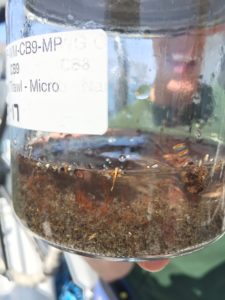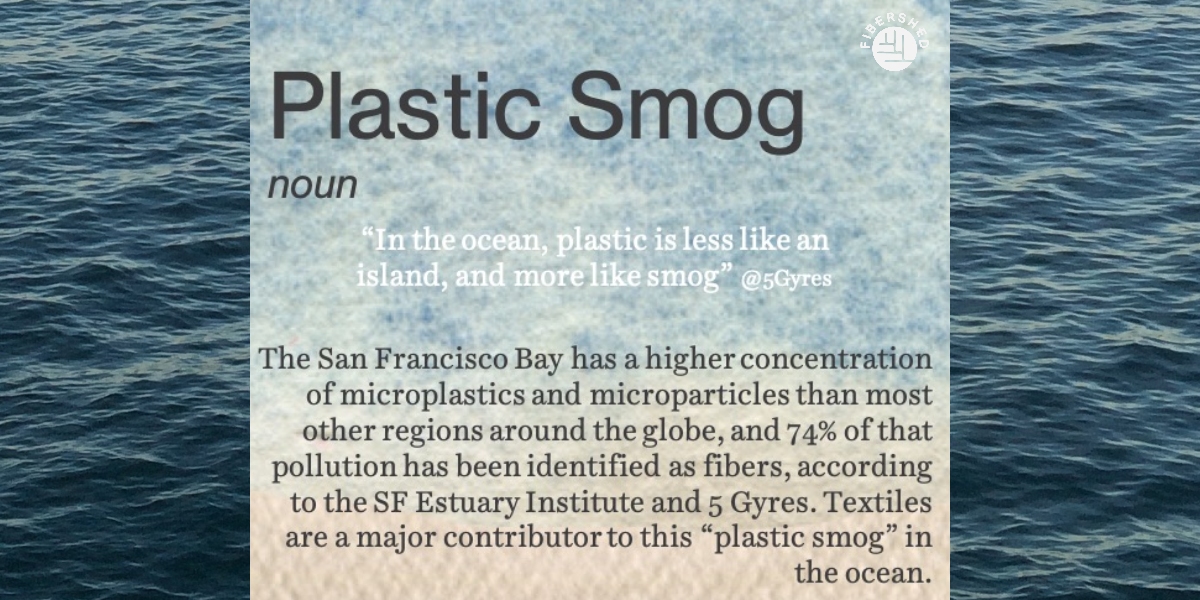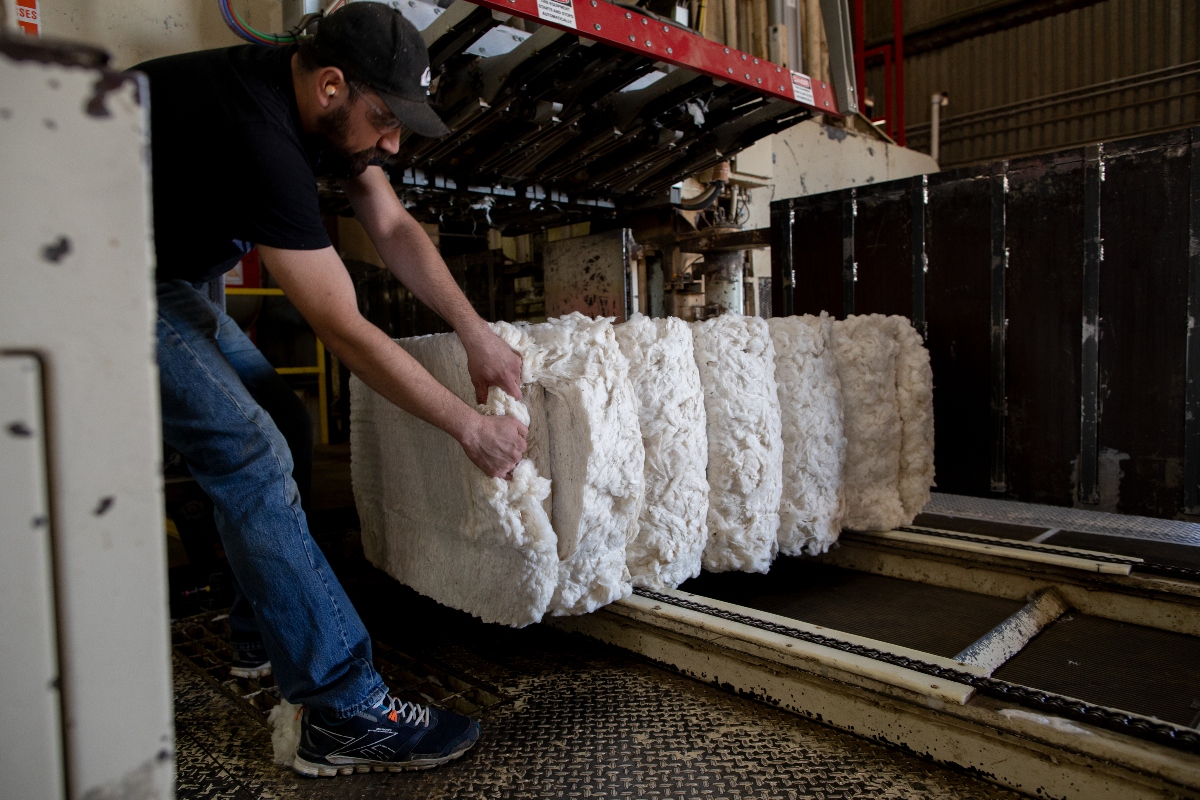By Jess Daniels

This is a big year for a vast yet microscopically small problem: microplastics. California is set to begin a series of regulatory and policy efforts aimed at understanding, measuring, and strategizing to mitigate the plastic smog that blankets our waterways, soils, and even air. With more than 7 Trillion microplastic particles pouring annually into the SF Bay alone, and research emerging every month about the risks posed to our respiratory health, soil and plant functioning, and marine life, we applaud the state for embarking on this course of action.
And with this rising tide of focus on microplastics, we need to make sure that we stay the course on targeting the greatest source of this pervasive pollution: synthetic fiber and textiles.
California will be the first in the world to set health guidelines for microplastics in drinking water. We have seen California as a leader in public health and environmental regulation, pushing the envelope on issues from air pollution to toxic chemicals in food and consumer products. Now, the State Water Board is developing a standard methodology and requirements for testing and reporting microplastics in drinking water throughout California that will go into effect in 2021.
It doesn’t stop at our tap: California’s Ocean Protection Council has convened a series of meetings to scope a statewide microplastics strategy. The Council, a governmental body established by the California Ocean Protection Act, is currently exploring how microplastics fit into their Recommended Actions to Address Plastic Pollution in California’s Coastal and Marine Ecosystems.
Recognizing the wide reach and risks of microplastic pollution, the California Assembly’s Environmental Safety & Toxic Materials Committee hosted a hearing on this issue last month. Chaired by Assemblymember Bill Quirk (D-Hayward), the hearing brought together scientists from California, Canada, and Europe to focus on “Microplastics in our Water and Environment: Understanding a Growing Pollution Source.”

At Fibershed, we are looking through the plastic smog to clearly understand that textiles and fashion have an outsized role in microplastic pollution. Since our first public presentation on this topic at the 2017 Fibershed Wool & Fine Fiber Symposium, we have learned that:
- 74% of microplastic pollution in the SF Bay is comprised of fibers, according to a 3-year study by the SF Estuary Institute and 5 Gyres Institute
- 53% of that microfiber was clearly identified as plastic (polyester, acrylic, and more), while another significant portion was identified as unspecified man-made material
- 7 Trillion microplastic particles enter the SF Bay through stormwater each year. (These particles come from microplastic in the air, roads and other surfaces, separate from the particles emitted through washing machines and wastewater).
- Recycled polyester sheds at a greater rate — almost 2x as many microplastic microfibers as virgin polyester
The waves of concern and consciousness about microplastics have mostly focused so far on our washing machines, with proposed solutions like microfiber-capturing clothing bags, balls, and washing machine filters. But the latest research shows that just by wearing our clothing or using our pillows and blankets, synthetic fabrics release microfiber microplastics into the air. Airborne microplastics emitted by the everyday use of synthetic clothes and textiles has been overlooked in many of the policy and research conversations about microplastic pollution, despite growing evidence that it may be an even more significant source of concern for human health.
We also know that both airborne and waterborne microplastics flow directly into ecosystems, even when they are passed through a Wastewater Treatment Plant. In California, biosolids from treated municipal waste are recycled onto agricultural fields to add nutrients to the soil. Researchers are now realizing that this practice is filling our soils with microplastic particles, including vast amounts of microfibers, that blanket the soil food web and likely impede healthy plant growth.
This is just the tip of the iceberg (which, sadly, likely also has billions of microplastics embedded). Yet, it points to a clear message: since an overwhelming source of microplastics is microfiber, we need fiber systems solutions.

And this is why our team and community at Fibershed are lifting our voices to share informed analysis and a grounded vision for addressing microplastic pollution. “With the growing alarm on microplastics, we know that the momentum for action is building” says Heather Podoll, Fibershed’s Partnership and Advocacy Coordinator. “It’s critical to ensure fibers are at the core of the conversation around understanding the scale and concerns of microplastic pollution and strategizing solutions.” So far this year, Fibershed has woven this message into key stakeholder collaborations including:
- Submitting detailed comments outlining the role of synthetic fibers in microplastics pollution, and how policy can create levers of change with natural fiber systems, provided to the Ocean Protection Council at their first quarter meeting on statewide strategies
- Joining the California Product Stewardship Council to participate in their textiles work and grow a vision for producer responsibility in clothing recycling and environmental impacts
- Partnering with a coalition to support the Plastics Free California bond measure, which is focused primarily on macro-plastics reduction and recycling, while opening pathways to broader materials management innovation
It can feel overwhelming to acknowledge the ubiquity of microplastic pollution alongside growing evidence of the potential for this pollution to harm human and ecosystem health. However, it’s important to recognize we have clear and present alternatives at our fingertips. For the past ten years, Fibershed has been mapping, identifying, and connecting natural fiber and dye resources in the Northern and Central California region. All textiles release microscopic fibers, but natural fibers that are not treated with harmful additives will biodegrade and can even nourish microorganisms.
“When we talk about the volume and impacts of microplastic pollution, we need to also connect it to the sharp rise of polymers in our fiber systems, which have been displacing natural fibers since the mid twentieth century” notes Fibershed’s founder, Rebecca Burgess. Fossil-carbon derived fibers are the bedrock of a cheap clothing economy that overproduces fashion at alarming rates, and now we’re seeing how it spreads throughout our ecosystems and our own bodies too.

Natural fiber systems are still here and in fact, producers and manufacturers are ready to be part of multi-systems solutions for environmental restoration. “Our community, and so many of our peer communities, includes fiber producers who are eager to improve soil health and climate resilience with carbon farming practices” says Burgess, “and with the financial and engineering expertise of the Regional Fiber Manufacturing Initiative, we have fine-tuned the models of rebuilding infrastructure with green jobs that process our natural fiber resources into clothing and durable goods that are healthy for people and planet.”
To join us in activating this vision, please sign up for our email newsletter for up-to-date opportunities to take action. If you would like more information about avoiding microplastics in your clothing choices, please download our free Fibershed Clothing Guide: A Menu of Actions and Options.
